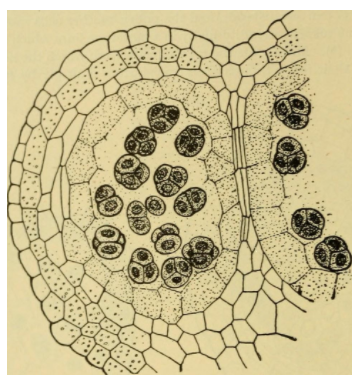
In dicots, the most common type of pollen tetrad is
a. Isobilateral
b. Linear
c. Tetrahedral
d. Decussate
Answer
499.5k+ views
2 likes
Hint: These types of tetrads are known as obligate or permanent tetrads. Pollen grains are arranged in two different planes. Three grains are in one plane and one lies centrally over the other three.
Complete answer: Tetrad is a gathering of four haploid and immature pollen grains in tetrahedral fashion produced by meiotic microsporogenesis. The tetrads are of fundamentally five types namely tetrahedral (commonly), isobilateral, T shaped, decussate, and linear. In dicots, the widely recognized type of pollen tetrad is tetrahedral. The pollen grains are created within the anther of the flower. Pollen mother cells originate from the sporogenous tissue of the anther which later divides meiotically to form four pollen grains called a tetrad.
Four pollen grains are joined to form a tetrad. Tetrads are the unseparated result of meiosis. Tetrads may be categorized into diverse types based on their arrangement.
In some cases, the pollen grains are delivered from the anther in the tetrad state. Other names of these types of tetrads are obligate or permanent tetrads, viz., Drimys (Winteraceae), Drosera (Droseraceae), Rhododendron Ericaceae).
Hence, Option (C) is the correct answer.

Additional Information:
Pollen morphology can be helpful in the determination of phylogeny and mating systems of plants. Pollen ovule ratios can give a sign of the mating system of plant species, and there are numerous theories as to decrease in response to pollination techniques.
Note:
Moreover, morphological features of pollen grains have been categorized into many other diverse groups: 1. Pollen Units 2. Polarity 3. Symmetry 4. Shape 5. Size 6. Apertures 7. Sub-Divisions of the Pollen Surface 8. Sporoderm Stratification 9. Exine Ornamentation 10. ‘LO’ Analysis.
Complete answer: Tetrad is a gathering of four haploid and immature pollen grains in tetrahedral fashion produced by meiotic microsporogenesis. The tetrads are of fundamentally five types namely tetrahedral (commonly), isobilateral, T shaped, decussate, and linear. In dicots, the widely recognized type of pollen tetrad is tetrahedral. The pollen grains are created within the anther of the flower. Pollen mother cells originate from the sporogenous tissue of the anther which later divides meiotically to form four pollen grains called a tetrad.
Four pollen grains are joined to form a tetrad. Tetrads are the unseparated result of meiosis. Tetrads may be categorized into diverse types based on their arrangement.
In some cases, the pollen grains are delivered from the anther in the tetrad state. Other names of these types of tetrads are obligate or permanent tetrads, viz., Drimys (Winteraceae), Drosera (Droseraceae), Rhododendron Ericaceae).
Hence, Option (C) is the correct answer.

Additional Information:
Pollen morphology can be helpful in the determination of phylogeny and mating systems of plants. Pollen ovule ratios can give a sign of the mating system of plant species, and there are numerous theories as to decrease in response to pollination techniques.
Note:
Moreover, morphological features of pollen grains have been categorized into many other diverse groups: 1. Pollen Units 2. Polarity 3. Symmetry 4. Shape 5. Size 6. Apertures 7. Sub-Divisions of the Pollen Surface 8. Sporoderm Stratification 9. Exine Ornamentation 10. ‘LO’ Analysis.
Latest Vedantu courses for you
Grade 11 Science PCM | CBSE | SCHOOL | English
CBSE (2025-26)
School Full course for CBSE students
₹41,848 per year
Recently Updated Pages
Master Class 12 Business Studies: Engaging Questions & Answers for Success

Master Class 12 English: Engaging Questions & Answers for Success

Master Class 12 Social Science: Engaging Questions & Answers for Success

Master Class 12 Chemistry: Engaging Questions & Answers for Success

Class 12 Question and Answer - Your Ultimate Solutions Guide

Master Class 12 Economics: Engaging Questions & Answers for Success

Trending doubts
Give 10 examples of unisexual and bisexual flowers

Draw a labelled sketch of the human eye class 12 physics CBSE

Differentiate between homogeneous and heterogeneous class 12 chemistry CBSE

Differentiate between insitu conservation and exsitu class 12 biology CBSE

What are the major means of transport Explain each class 12 social science CBSE

Franz thinks Will they make them sing in German even class 12 english CBSE




